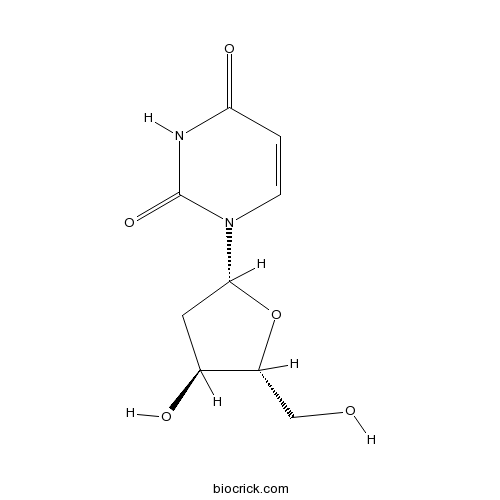2'-DeoxyuridineCAS# 951-78-0 |

Quality Control & MSDS
3D structure
Package In Stock
Number of papers citing our products

| Cas No. | 951-78-0 | SDF | Download SDF |
| PubChem ID | 13712 | Appearance | Powder |
| Formula | C9H12N2O5 | M.Wt | 228 |
| Type of Compound | N/A | Storage | Desiccate at -20°C |
| Solubility | Soluble in Chloroform,Dichloromethane,Ethyl Acetate,DMSO,Acetone,etc. | ||
| Chemical Name | 1-[(2R,4S,5R)-4-hydroxy-5-(hydroxymethyl)oxolan-2-yl]pyrimidine-2,4-dione | ||
| SMILES | C1C(C(OC1N2C=CC(=O)NC2=O)CO)O | ||
| Standard InChIKey | MXHRCPNRJAMMIM-SHYZEUOFSA-N | ||
| Standard InChI | InChI=1S/C9H12N2O5/c12-4-6-5(13)3-8(16-6)11-2-1-7(14)10-9(11)15/h1-2,5-6,8,12-13H,3-4H2,(H,10,14,15)/t5-,6+,8+/m0/s1 | ||
| General tips | For obtaining a higher solubility , please warm the tube at 37 ℃ and shake it in the ultrasonic bath for a while.Stock solution can be stored below -20℃ for several months. We recommend that you prepare and use the solution on the same day. However, if the test schedule requires, the stock solutions can be prepared in advance, and the stock solution must be sealed and stored below -20℃. In general, the stock solution can be kept for several months. Before use, we recommend that you leave the vial at room temperature for at least an hour before opening it. |
||
| About Packaging | 1. The packaging of the product may be reversed during transportation, cause the high purity compounds to adhere to the neck or cap of the vial.Take the vail out of its packaging and shake gently until the compounds fall to the bottom of the vial. 2. For liquid products, please centrifuge at 500xg to gather the liquid to the bottom of the vial. 3. Try to avoid loss or contamination during the experiment. |
||
| Shipping Condition | Packaging according to customer requirements(5mg, 10mg, 20mg and more). Ship via FedEx, DHL, UPS, EMS or other couriers with RT, or blue ice upon request. | ||

2'-Deoxyuridine Dilution Calculator

2'-Deoxyuridine Molarity Calculator
| 1 mg | 5 mg | 10 mg | 20 mg | 25 mg | |
| 1 mM | 4.386 mL | 21.9298 mL | 43.8596 mL | 87.7193 mL | 109.6491 mL |
| 5 mM | 0.8772 mL | 4.386 mL | 8.7719 mL | 17.5439 mL | 21.9298 mL |
| 10 mM | 0.4386 mL | 2.193 mL | 4.386 mL | 8.7719 mL | 10.9649 mL |
| 50 mM | 0.0877 mL | 0.4386 mL | 0.8772 mL | 1.7544 mL | 2.193 mL |
| 100 mM | 0.0439 mL | 0.2193 mL | 0.4386 mL | 0.8772 mL | 1.0965 mL |
| * Note: If you are in the process of experiment, it's necessary to make the dilution ratios of the samples. The dilution data above is only for reference. Normally, it's can get a better solubility within lower of Concentrations. | |||||

Calcutta University

University of Minnesota

University of Maryland School of Medicine

University of Illinois at Chicago

The Ohio State University

University of Zurich

Harvard University

Colorado State University

Auburn University

Yale University

Worcester Polytechnic Institute

Washington State University

Stanford University

University of Leipzig

Universidade da Beira Interior

The Institute of Cancer Research

Heidelberg University

University of Amsterdam

University of Auckland

TsingHua University

The University of Michigan

Miami University

DRURY University

Jilin University

Fudan University

Wuhan University

Sun Yat-sen University

Universite de Paris

Deemed University

Auckland University

The University of Tokyo

Korea University
- PF-670462
Catalog No.:BCC1856
CAS No.:950912-80-8
- trans-4-Hydroxy-2-nonenoic acid
Catalog No.:BCN7959
CAS No.:95087-42-6
- Quizartinib (AC220)
Catalog No.:BCC2548
CAS No.:950769-58-1
- PCI-34051
Catalog No.:BCC2148
CAS No.:950762-95-5
- B-Raf IN 1
Catalog No.:BCC5439
CAS No.:950736-05-7
- 6-O-Methacryloyltrilobolide
Catalog No.:BCN7599
CAS No.:950685-51-5
- Gemcitabine
Catalog No.:BCC3784
CAS No.:95058-81-4
- Liproxstatin-1
Catalog No.:BCC5651
CAS No.:950455-15-9
- Erianin
Catalog No.:BCN2350
CAS No.:95041-90-0
- Pyrolin
Catalog No.:BCN6902
CAS No.:95-71-6
- 2-(Morpholinodithio)benzothiazole
Catalog No.:BCC8484
CAS No.:95-32-9
- 2-Benzothiazolyl diethyldithiocarbamate
Catalog No.:BCC8558
CAS No.:95-30-7
- Boc-N-Me-Tyr-OH.DCHA
Catalog No.:BCC3355
CAS No.:95105-25-2
- Desformylflustrabromine hydrochloride
Catalog No.:BCC7651
CAS No.:951322-11-5
- Artemetin acetate
Catalog No.:BCN4501
CAS No.:95135-98-1
- DY131
Catalog No.:BCC1539
CAS No.:95167-41-2
- Herpetone
Catalog No.:BCN2812
CAS No.:951677-22-8
- Fmoc-Lys(Me,Boc)-OH
Catalog No.:BCC2566
CAS No.:951695-85-5
- Sibiricin
Catalog No.:BCN4502
CAS No.:95188-34-4
- PF-477736
Catalog No.:BCC4421
CAS No.:952021-60-2
- Parishin E
Catalog No.:BCN3814
CAS No.:952068-57-4
- Atovaquone
Catalog No.:BCC4890
CAS No.:95233-18-4
- Neocaesalpin L
Catalog No.:BCN7650
CAS No.:952473-86-8
- 11-Oxomogroside III
Catalog No.:BCN3169
CAS No.:952481-53-7
Suppression of Light-Induced Retinal Degeneration by Quercetin via the AP-1 Pathway in Rats.[Pubmed:30934771]
Antioxidants (Basel). 2019 Mar 27;8(4). pii: antiox8040079.
We examined the cytoprotective effect of quercetin via activator protein (AP-1) and the heat shock protein 70 (Hsp70) pathway against light-induced retinal degeneration in rats. Quercetin was administered intraperitoneally to Sprague-Dawley rats for seven days before light exposure to intense white fluorescent light (3000 lux) for 24 h. Light-induced retinal damage was determined by the number of rows of photoreceptor cell nuclei, the microstructures of the rod outer segments and retinal pigment epithelium, and terminal deoxynucleotidyl transferase (TdT)-mediated 2'-Deoxyuridine-5'-triphosphate (dUTP) nick end labeling. To elucidate the cytoprotective mechanism of quercetin, expression levels were measured in the rat retinas of 8-hydroxy-deoxyguanosine (8-OHdG), a marker of oxidative stress; Hsp70; and transcription factor AP-1 transcription activity. Pretreatment with quercetin inhibited light-induced photoreceptor cellular apoptosis and subsequent retinal degeneration in rats. 8-OHdG and Hsp70 protein expressions were up-regulated markedly by light exposure and suppressed by quercetin pretreatment. The results of an electrophoretic mobility shift assay showed that AP-1-binding activity was activated by light exposure, and binding of c-Fos and c-Jun, but not JunB, mediated the binding activity. Intraperitoneal administration of quercetin decreases photooxidative damage in the retina and mediates cytoprotection against light-induced photoreceptor cell degeneration in rats. Suppression of the heterodimeric combination of c-Jun and c-Fos proteins at the AP-1 binding site is highly involved in quercetin-mediated cytoprotection.


